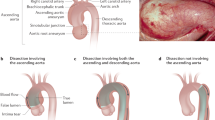Summary
The Marfan syndrome is an autosomal dominant disorder of the connective tissue with mutations on the fibrillin-1 gene encoding for fibrillin, a major component of the extracellular microfibrils. The prevalence of the syndrome is 7–17/100,000. The mean life expectancy for untreated patients with Marfan syndrome is 32 years with aortic dissection, aortic rupture or cardiac failure due to mitral and aortic valve regurgitation as the predominant cause of death in >90% of the cases. In severely affected cases with neonatal Marfan syndrome, patients are likely to survive only a few months. According to the literature database the prevalence of aortic dilatation is 76%, 26% for aortic regurgitation, 62% for mitral valve prolapse, and 29% for mitral valve regurgitation in adult patients with classic Marfan syndrome. Pathogenesis and the natural cause of each cardiovascular manifestation is thoroughly discussed with the problems resulting from associated cardiac arrythmias, sudden cardiac death, endocarditis, and less frequent cardiovasular manifestations of the Marfan syndrome. Special focus is placed on the analysis of cardiocvasular complications during pregnancy.
Zusammenfassung
Beim Marfan-Syndrom handelt es sich um eine autosomal dominant vererbte Erkrankung mit Veränderungen der 10–12-nm-Mikrofibrillen durch Mutation des Fibrillin-1-Gens. Die Prävalenz des Marfan-Syndroms liegt bei 7 bis 17 Fällen von 100 000 Personen der Bevölkerung. Aufgrund von Dissektion und Ruptur der Aorta sowie Herzklappenfehlern liegt die mittlere Lebenserwartung ohne Behandlung bei 32 Jahren, in schweren Fällen (sogenanntes neonatales Marfan-Syndrom) bei nur wenigen Monaten. Nach aktueller Datenanalyse kommt es beim klassischen Marfan zu einer Aortendilatation mit der Gefahr der Dissektion in 76%, zur Aortenklappeninsuffizienz in 26%, zum Mitralsegelprolaps in 62% und zur Mitralklappeninsuffizienz in 29% der Fälle. Die Pathogenese und der natürliche Verlauf dieser kardiovaskulären Manifestationen sowie die Bedeutung der assoziierten Phänomene, wie Herzrythmusstörungen, plötzlicher Herztod, Endokarditits, seltener kardiovaskuläre Manifestationen und das Risiko einer Schwangerschaft, werden im Dialog zwischen Literatur und eigenen Daten analysiert.
Similar content being viewed by others
Author information
Authors and Affiliations
Additional information
Eingegangen: 9. Oktober 1997 / Akzeptiert: 13. Januar 1998
Rights and permissions
About this article
Cite this article
v. Kodolitsch, Y., Raghunath, M. & Nienaber, C. Das Marfan-Syndrom: Prävalenz und natürlicher Verlauf der kardiovaskulären Manifestitionen. Z Kardiol 87, 150–160 (1998). https://doi.org/10.1007/PL00007349
Issue Date:
DOI: https://doi.org/10.1007/PL00007349




